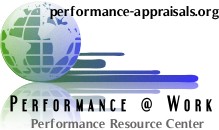Understanding Rating and Ranking Systems and Their Limitations In Improving Performance
What's the most common method used in performance appraisals? It's an easy question. it's not 360 degree feedback. It's not narratives and anecdotal methods. It's not direct observation and using actual metrics of productivity.
It's employee ratings.
Sadly, rating employees on some sort of scale, while common, is one of the worst ways to both evaluate performance, and improve performance. And when coupled with ranking employees with respect to each other, the entire process ends up NOT able to identify the most valuable or even weakest employees, resulting in poor decisions.
This is such an important element in the workplace that we've devoted this page to understanding ratings, their evil cousins, employee rankings, and their limitations.
First, All About Documenting Employee Performance
Rating systems, and for that matter the completion of paper or computer based forms constitute a process of documenting employee performance. It's a simple process -- simply recording and saving information.
- Understanding That All Documentation Methods and Forms Are Flawed
The tools used in companies to document performance are ALL flawed. Understanding the strengths, and more importantly, the weaknesses of the tools you are asked to use is the first step to manage performance effectively. - So Why Spend So Much Time Documenting and Recording Employee Performance?
Documenting employee performance takes time, and it's NOT the documentation per se that improves performance. So why does it have to be done at all?
The Various Employee Performance Documentation Methods
- Introduction To Employee Rating Scales And Items
An overview of the use of rating scales, including examples of worse and better scale items. - Introduction To Ranking Employees
Technically not a way of documenting performance as much as taking information about employee performance and using that information to rank employees, or compare them to each other.
Narrative And Critical Incident Methods
- Using A Narrative Process To Document Performance
Narratives are another way to record, document and use to improve performance. In many ways they have more potential for improving performance than to rating systems. - Strengths and Weaknesses Of The Narrative Approach - Pro's, Con's
Explore the pro's and con's of using a narrative approach to documenting employee performance. - The Critical Incident Approach To Performance Management & Review: Strengths and Weaknesses
Learn how to use the critical incident method of noting aspects of employee performance, and the method's strengths and weaknesses. Can be used stand alone, or as a add-on to horrible rating forms.
MBO - Management By Objectives
- Introduction To Management By Objectives (MBO)
Here's an overview of the Management By Objectives Approach To Employee Management and Appraisal. - MBO: Strengths and Weaknesses of The MBO Technique
Every approach to management has flaws and weaknesses. We'll provide you with a rundown here. - Tips For Succeeding WIth MBO
In a hurry? Here are three essential hints and tips for making MBO work and succeed.
Bringing MBO Into The 21st Century - Step 1 (coming soon)
360 Degree Feedback
- 360 Degree Feedback Comes WIth Huge Limitations and Dangers - Strengths
360 degree feedback and/or multi-rater feedback have some intuitive attractions, and in fact have a number of strengths. Here's an explanation of the procedure, and why it seems like a good idea. - The Hazards of 360 Feedback, And Why They Don't Result In Better Performance
You'd think 360 feedback systems would improve productivity and performance, but they don't, usually. The reasons have to do with some characteristics of the system. Read about these weaknesses. - Maximizing The Effectiveness of 360 Feedback
Some tips for success, and pitfalls to avoid.
